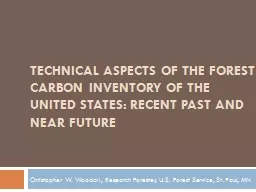

Christopher W Woodall Research Forester US Forest Service St Paul MN Grant Domke Sean Healey John Coulston James Smith Andrew Gray CoAuthors Outline Where weve been Where we are at ID: 271603
Download Presentation The PPT/PDF document "TECHNICAL ASPECTS OF THE FOREST CARBON I..." is the property of its rightful owner. Permission is granted to download and print the materials on this web site for personal, non-commercial use only, and to display it on your personal computer provided you do not modify the materials and that you retain all copyright notices contained in the materials. By downloading content from our website, you accept the terms of this agreement.
Slide1
TECHNICAL ASPECTS OF THE FOREST CARBON INVENTORY OF THE UNITED STATES: RECENT PAST AND NEAR FUTURE
Christopher W. Woodall, Research Forester, U.S. Forest Service, St. Paul, MN Slide2
Grant DomkeSean HealeyJohn
Coulston
James SmithAndrew Gray
Co-AuthorsSlide3
OutlineWhere we’ve been…Where we are at…
Where we want to go…Slide4
FIA Carbon/Biomass Goal“Improve forest biomass/carbon estimates
using the
sound science in concert with our external partners/scientists. Just as we try to provide the best volume estimates across the country, we should produce the best biomass/carbon estimates”Slide5
State of Accounting in 2010Live Tree = Field Measurement
Standing Dead Tree =
ModelLitter = ModelDowned Dead Wood =
ModelSoil Organic Carbon = Model
Belowground =
Model
Data Delivery =
FIA
vs
NGHGI Tools
Vs.
* Used in 2009 National Greenhouse Gas Inventory of Forests (LULUCF)Slide6
Problem with Models
Do trees really grow/die in such a stable manner?
How about invasive earthworms and warming temperature impact on litter depth?
How about western tree mortality and fires?Slide7
Problem with Modelse.g., 1,000 year ice stormSlide8
Improvements in 2011
Jenkins to Component Ratio Method
Phase 2 standing dead
Released to Public in April 2012Slide9
Improvements in 2012Phase 3 Down Woody Materials
Released to Public in April 2013Slide10
CRM vs. Jenkins
Jenkins
Nationally consistent method
Tree component estimates
Single field-based parameter:
dbh
Useful at large scales
Not linked to tree volume
Relies on external stump equation
Component Ratio Method (CRM)
Nationally consistent method
Standardized use of regional volume equations
Utilizes dbh and height measurements
Requires Jenkins to estimate component biomass
Incorporates rotten and missing cull deductions
Relies on external stump equationSlide11
CRM vs. Jenkins
Method
Jenkins:
CRM:
79.5 kg C
70.0 kg C
25.0 kg C
21.7 kg C
4.9 kg C
4.3 kg C
109.4 kg C
96.0 kg C
Bole
Top and limbs
Stump
Total AG carbonSlide12
CRM vs. Jenkins
9 inch tree biomass by tree height across United States
Douglas-fir
Quaking AspenSlide13
CRM vs. JenkinsWoodall, C.W., Heath, L.S., Domke, G.M., Nichols, M.C. 2011. Methods and equations for estimating aboveground volume, biomass, and carbon for trees in the U.S. forest inventory, 2010. Gen. Tech. Rep. NRS-88. Newtown Square, PA: U.S. Department of Agriculture, Forest Service, Northern Research Station. 30 p.
Domke, G.M., Woodall, C.W., Smith, J.E., Westfall, J.A., McRoberts, R.E. 2012. Consequences of alternative tree-level biomass estimation procedures on U.S. forest carbon stock estimates. Forest Ecology and Management. 270: 108-116. Slide14
National Volume/Biomass Effort
Consortium
Collect Data Progressively Through SpeciesSlide15
Standing Dead Trees Inventory PlotsSlide16
Standing Dead WoodWood density
Structural lossSlide17
Density Reduction FactorsSlide18
Density Reduction FactorsSlide19
Structural Loss AdjustmentSlide20
Models vs. MeasurementsModels may not account for recent disturbance mortality such as fire or insectsSlide21
Western State Standing Dead Trees
C
Wilson et al. In ReviewSlide22
Standing Dead Research
Woodall, C.W., Domke, G.M., MacFarlane, D.W., Oswalt, C.M. 2012. Comparing field- and model-based standing dead tree carbon stock estimates across forests of the United States. Forestry. 85: 125-133.
Domke, G.M., Woodall, C.W., Smith, J.E. 2011. Accounting for density reduction and structural loss in standing dead trees: Implications for forest biomass and carbon stock estimates in the United States. Carbon Balance and Management 6: 14. Slide23
Implications of Changes to 2012 US LULUCF
Not all changes
are due to the revised estimation procedures for live and standing dead trees (e.g., new inventories). Reduction in US C stocks by
6.7% (3,232 Tg C) Increase
in US C annual sequestration (2009 inventory year) by
3.5%
(8.3
Tg
C/yr)
CRM adoption was partially responsible for
reducing
AG live tree stocks (2010) by
15.2%
(2,606 Tg C). However, annual stock change (2009) increased by 0.9% (1.2 Tg C/yr)
Using FIA Phase 2 standing dead trees reduced standing dead tree US stocks (2010) by 14.8% (458 Tg C). However, annual stock change (2009) increased by 122.2% (11.0 Tg C/yr).Slide24
Phase 2 vs Phase 3 Plots
Phase 2
1 per 6,000 acres
Phase 3
1 per 96,000 acres
Soils
Downed Woody Materials (
DWM
)
Forest Floor
Understory VegetationSlide25
DWM Plots
27,000+ plots
Sampled 2002-2010Slide26
Unique DWM Considerations (i.e., Decay)
Height collapse (volume)
Case hardeningDensity reductionsHarmon et al. 2008 (NRS-GTR-29)Slide27
Prior NGHGI Model
Live Tree Biomass
Downed Dead Biomass
Smith et al. 2006Slide28
DWM P3 vs. NGHGI Model
Field-based
Model: Carbon calculation tool
Estimated CWD C density (Tg)
Domke et al. In reviewSlide29
DWM P3 vs. NGHGI Model
Domke et al. In reviewSlide30
Live versus Dead versus Area
Woodall et
al. In Review.Slide31
Bringing it All Together: A Cohesive View of C Across Pools and US
Wilson et al. In ReviewSlide32
Future WorkInterior Alaska and Managed Land Definition
Missing Data and 1990 Baseline
CCT for National Forest SystemSoil Organic Carbon and Forest FloorBelowground
Unity among on-line reporting toolsVolume/Biomass researchAnd so on…Slide33
SummaryImproving estimation of each pool…step by step
CRM adoption and standing dead refinements in 2011
Downed dead wood in 2012 (right now)Soil organic carbon and forest floor in 2013Small group that tries to leverage the community of carbon scientistsSlide34
Thank You!!!cwoodall@fs.fed.us